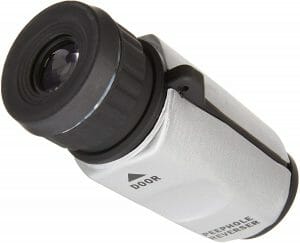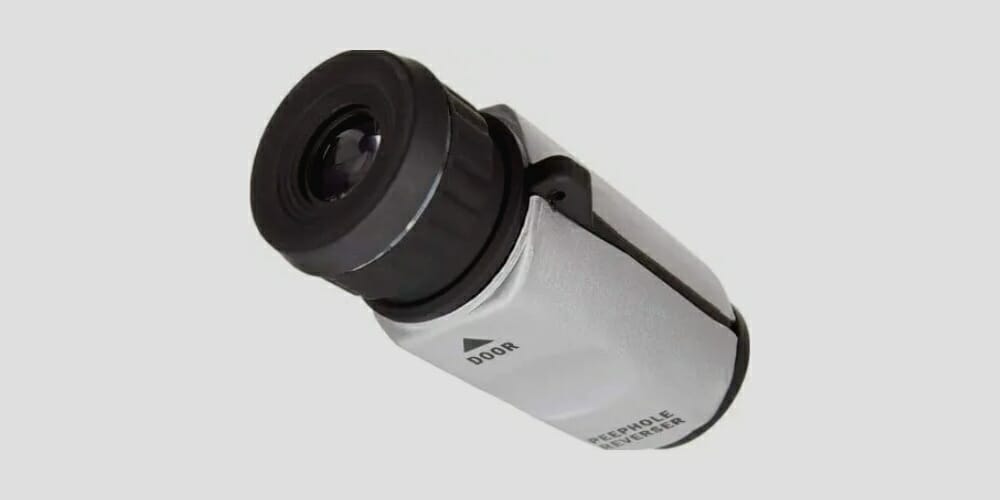Are you afraid someone may be in your home or hotel room before you even get in?
To prevent “surprises,” using Reverse Peephole Viewers (RPVs) could help us in these risky situations. To create a reverse peephole viewer, you would need a lot of skill in accommodating different lenses. It would be incredibly difficult to make one rather than buy one. I will explain exactly how these work and what lenses they use. If you decide to make one as a do-it-yourself project, you will need to assemble the correct lenses using the information ill provide you below.
What is a Peephole Viewer (PV)?

A Peephole viewer is used as a security measure to confirm who is there and what happens outside, almost as old as when doors began to be installed in homes.
Hole dimensions and door thickness with a simple Peephole limit the visual angle. The thicker the door, the more the viewing angle is proportionally reduced.
The peephole viewer is a small device, generally installed in the central part, at a person’s height, in the external doors as a security device. Due to its particular design, it provides users with an angular view (around 120-180 °) to allow them to get a wide view of the space outside.
Another important feature of the design is that if someone from the outside wants to see the inside through the PV, they will see a very small and distorted image.
To do this, the PV uses a Fisheye lens at the external surface of the door. (1)
These lenses catch a wide range of light rays’ directions from outside space. Some additional lenses will modify the image and concentrate it for the human eye on the inner surface of the door. The image provided has a unique perspective, allowing us to see what is outside the door.
How do Peephole Viewers work?
To get this wide view and “one-way vision,” the PV has a special combination of lens types. They are placed at the proper distance, using the principles of diffraction of light rays to obtain this particular effect.
Usually, the lenses are located in a cylinder metal structure with a plate at the end of both sides of the cylinder. These plates are the view portion of the peephole on each door side.
What is a Reverse Peephole Viewer?
A reverse peephole viewer is a small device that lets you see through the installed PV on doors from the outside to the inside of the room.
You must put the RPV next to the outside portion of the PV and see it with the RPV viewer. It provides a clear vision of the room next to the door.
How Does a Reverse Peephole Viewer Work?
The RPV uses the same principles of light ray diffraction of PV to reverse its image effects.
Therefore, within the RPV, there is a special arrangement of lenses, with distance adjustments between them, to obtain focus.
Basic Components of a Reverse People Viewer?
The main component within an RPV is the lenses. These are in charge of modifying the light rays.
Lenses are transparent components of glass, crystal, or plastic, limited by two surfaces, at least one being curved. There are two types of lenses :
Convergent: they are thicker in the center than at the edge and concentrate (converge) the light rays that pass through them at a focus point.
Divergent: they are thicker at the edges than in the center, and they disperse light rays that pass through them.
RPV devices are made by:
- Lens A is a converging lens that takes the divergent light rays from the PV fisheye lens and prepares it for the next lens. It can be a convex face and the other concave. (2)
- Lens B: There is a group of lenses to convert the image received from Len A into the correct position and dimension to be usable by the human eye.
- Structure: Typically, a metal cylinder is used as a frame to locate each lens. Due to different PV designs, some of these lenses must be moved through the cylinder’s axis to adjust the focus.
- Theory Calculation: The dimensions, distances, and lens shapes must be supported by the theory of difracción and lens calculations to obtain relevant results.
Considerations
You have to take into count some points to obtain appropriate usage for an RPV:
- Light: The RPV will not be useful if the room we want to see is dark or with poor light. Therefore, we must consider maintaining a minimum lighting condition before leaving the room.
- Unblocked: Some PVs have a mechanism to block the hole. This prevents outside-in vision but must be open for RPV to work.
- Handling: The RPV has to be portable. They should be with us when we return to our place or easy to locate in a secret place near our door.
Actual Security Alternatives
The PV was an excellent invention for security at the time. From that moment on, the technological improvements have been huge. Now peepholes integrated with WiFi, with infrared visions, can send messages if something is detected outside or inside.
Wrapping Up
RPV is one of the tools used as a fence for personal security. Available to be used indoors with a PV device. Although the peephole viewer was invented at the beginning of the previous century, still it’s used in many homes and hotels.
In the market, you can find some options for this kind of device.
References
(1) Fisheye – https://electronics.howstuffworks.com/cameras-photography/tips/fisheye-lens-photography.htm
(2) lens – https://www.britannica.com/technology/lens-optics

